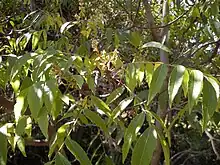Jagera pseudorhus
Jagera pseudorhus, commonly named foambark, is a species of rainforest trees, in the northern half of eastern Australia and in New Guinea, constituting part of the flowering plant family Sapindaceae. Named for the saponin foam that forms on the bark after heavy rain.
| Jagera pseudorhus | |
|---|---|
 | |
| Jagera pseudorhus - leaves and flowers | |
| Scientific classification | |
| Kingdom: | Plantae |
| Clade: | Tracheophytes |
| Clade: | Angiosperms |
| Clade: | Eudicots |
| Clade: | Rosids |
| Order: | Sapindales |
| Family: | Sapindaceae |
| Genus: | Jagera |
| Species: | J. pseudorhus |
| Binomial name | |
| Jagera pseudorhus | |
| Synonyms[1] | |
| |
In Australia, they grow naturally from the Manning River (35° S), New South Wales to the Bloomfield River (15° S) in far north Queensland.[2][3][4][5] In New Guinea they grow naturally widespread.[6] The habitat is tropical and sub-tropical rainforests, monsoon forest and gallery forest on soils of good fertility. Other common names include ferntop and pink tamarind.
Two varieties have formal botanical descriptions:
- Jagera pseudorhus var. integerrima S.T.Reynolds – endemic to the Atherton Tableland, Qld, Australia[3]
- Jagera pseudorhus var. pseudorhus – NSW, Qld, Australia and New Guinea[2][4][6]
Description
Growing to 30 m (98 ft) tall and 50 cm (20 in) in trunk diameter. Though smaller in cultivation. The bark is smooth and grey with horizontal raised ridges. The base of larger trees are often flanged.
Leaves are alternate and pinnate with eight to twenty six leaflets. The leaflets 4 to 6 cm long. Toothed, not equal at the base, with a pointed tip. Branchlets and the underside of leaves hairy.
Yellow brown flowers form on panicles in the months of March to May. The fruit forms in August to November. Being a hairy capsule with three cells around 18 mm (0.7 in) long. Capsules mature to a brown colour, after being a violet pink. One seed in each cell, being covered in aril. Care needs to be taken when handling the capsule, as the hairs may cause skin irritation.
Fruit eaten by the Australian king parrot and the green catbird. Germination from fresh seed is not particularly difficult.
Uses
The form of this tree makes it well suited as an ornamental. Indigenous Australians use foam from crushed bark or leaves as a fish poison to kill fish enabling easy catching. The foam was also used as a soap.
References
- "Jagera pseudorhus". Australian Plant Name Index (APNI). Centre for Plant Biodiversity Research, Australian Government. Retrieved 7 June 2021.
- F.A.Zich; B.P.M.Hyland; T.Whiffen; R.A.Kerrigan (2020). "Jagera pseudorhus var. pseudorhus". Australian Tropical Rainforest Plants Edition 8 (RFK8). Centre for Australian National Biodiversity Research (CANBR), Australian Government. Retrieved 7 June 2021.
- F.A.Zich; B.P.M.Hyland; T.Whiffen; R.A.Kerrigan (2020). "Jagera pseudorhus var. integerrima". Australian Tropical Rainforest Plants Edition 8 (RFK8). Centre for Australian National Biodiversity Research (CANBR), Australian Government. Retrieved 7 June 2021.
- Harden, Gwen J. (July 2001). "Jagera pseudorhus (A.Rich.) Radlk. – New South Wales Flora Online". PlantNET – The Plant Information Network System. 2.0. Sydney, Australia: The Royal Botanic Gardens and Domain Trust. Retrieved 8 Dec 2013.
- Floyd, A. G. (1989). Rainforest Trees of Mainland South-eastern Australia (1st ed.). Port Melbourne: Elsevier Australia - Inkata Imprint, copyright Forestry Commission of New South Wales (published 1989-12-01). p. 366. ISBN 0-909605-57-2. Retrieved 2009-06-23. (other publication details, included in citation)
- Leenhouts, Pieter W. (1994). "Jagera pseudorhus var. pseudorhus". In Adema, F.; Leenhouts, P. W.; van Welzen, P. C. (eds.). Flora Malesiana (Digitised, online). Series I, Spermatophyta : Flowering Plants. Vol. 11 pt. 3: Sapindaceae. Leiden, The Netherlands: Rijksherbarium / Hortus Botanicus, Leiden University. p. 617. ISBN 90-71236-21-8. Retrieved 8 Dec 2013.